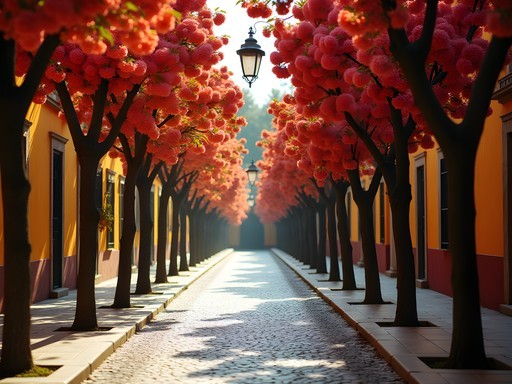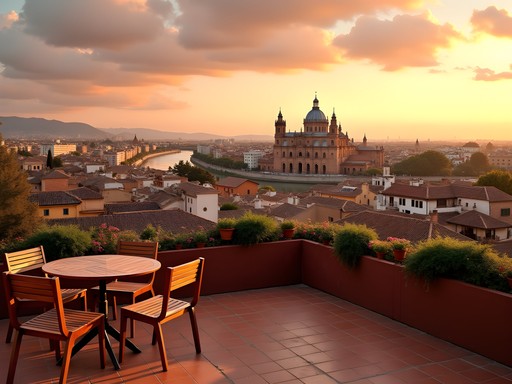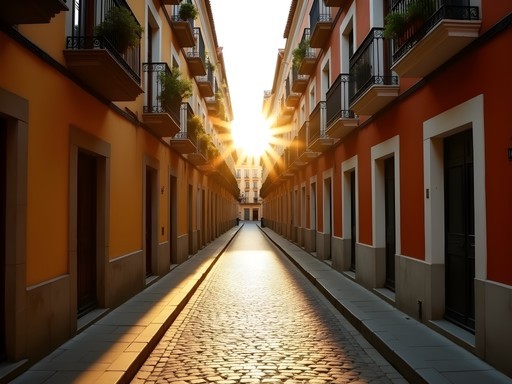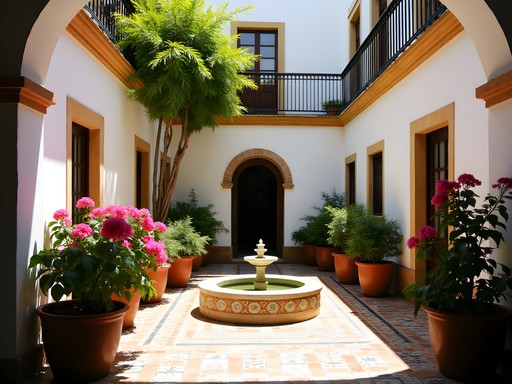Disclosure: This article contains affiliate links. We may earn a commission from purchases at no extra cost to you, which helps our travel content.
The first time I stepped onto Seville's cobblestone streets, the scent of orange blossoms hanging in the air and the distant echo of a flamenco guitar stopped me in my tracks. Coming from Miami's vibrant Cuban scene, I thought I understood passion—but Seville showed me an entirely new dimension. This Andalusian capital doesn't just preserve its traditions; it lives them with fierce pride and infectious joy. Having returned multiple times over the years (most recently to research this 2024 guide), I've learned that timing is everything when visiting this southern Spanish gem. The difference between experiencing Seville during its cultural high season versus any other time is like comparing a whisper to a symphony at full crescendo. If you're planning a romantic getaway or cultural immersion this year, let me walk you through the perfect week in Seville when the city truly comes alive.
Timing Your Visit: The Magic of Seville in Spring
If there's one season when Seville truly unveils its soul, it's spring. From late March through May, the city transforms into a stage where centuries-old traditions burst into life against a backdrop of perfect weather and blooming jacarandas.
My first spring visit was actually an accident—a rescheduled work trip that coincidentally landed me in Seville just before Semana Santa (Holy Week). What began as a professional detour became the most fortunate travel timing of my life. The temperature hovers between 18-25°C (65-77°F), warm enough for outdoor dining but cool enough before the infamous summer heat that regularly pushes thermometers above 40°C (104°F).
Spring in Seville isn't just about comfortable weather—it's when the cultural calendar reaches its magnificent peak. The consecutive celebrations of Semana Santa and Feria de Abril (April Fair) showcase Seville at its most authentic, with locals fully engaged in traditions that have defined their identity for centuries.
While accommodations are certainly pricier during this peak season, the cultural immersion is worth every euro. I've found that booking at least 5-6 months in advance is essential, especially if you want to stay within walking distance of the historic center. My go-to area is the Santa Cruz neighborhood, where the maze of narrow streets puts you in the heart of the action while still offering pockets of tranquility.

💡 Pro Tips
- Book accommodation at least 5-6 months in advance for spring visits
- Consider the Barrio Santa Cruz for authentic atmosphere with proximity to major sites
- Pack layers—spring evenings can be surprisingly cool after warm days
Semana Santa: Holy Week's Solemn Spectacle
My air traffic control career taught me precision and attention to detail, but nothing prepared me for the meticulous choreography of Semana Santa. This holy week preceding Easter transforms Seville into an open-air theater of faith and tradition that transcends religious boundaries.
The processions begin on Palm Sunday and continue through Easter, with the most dramatic displays occurring on Holy Thursday and Good Friday. Each day, different brotherhoods (hermandades) carry massive floats (pasos) depicting biblical scenes through the streets. These pasos, some weighing up to a ton, are carried on the necks and shoulders of costaleros—hidden bearers who train all year for this honor.
What struck me most was the contrast between the somber, hooded nazarenos (penitents) and the raw emotion of the saetas—spontaneous flamenco laments sung from balconies as the Virgin Mary passes. Even as someone raised with limited religious background, I found myself moved to tears by the pure emotional intensity.
The procession routes change slightly each year, but they always pass through the official route (carrera oficial) and the Cathedral. For the best experience, I recommend watching the processions from multiple vantage points:
- Stand along the official route near the Cathedral for the most formal presentation
- Find a spot in a narrow side street where the floats barely fit through (the precision is breathtaking)
- Position yourself near Plaza de San Francisco to see the processions rest
To truly understand what you're witnessing, consider investing in a Semana Santa guide that explains the symbolism and history. While the event is free to witness, a good guide helps you appreciate the profound cultural significance behind every detail.

💡 Pro Tips
- Download the official ICUS Semana Santa app for real-time procession tracking
- Wear comfortable shoes and bring water—you'll be standing for hours
- Respect the solemnity of the occasion by dressing modestly and speaking quietly
Feria de Abril: Seville's Spectacular Spring Festival
Just two weeks after the solemnity of Semana Santa, Seville undergoes a dramatic transformation as Feria de Abril (April Fair) erupts in a riot of color, music, and dance. This contrast perfectly encapsulates the Spanish approach to life—embracing both profound spirituality and unbridled joy with equal passion.
The Feria grounds (Real de la Feria) temporarily become Seville's alternate city center, with over 1,000 casetas (private tents) lining streets named just for the week-long celebration. While most casetas are private, requiring an invitation from local families or organizations, there are public casetas sponsored by the city where everyone is welcome.
During my first Feria, I felt like I'd stepped into a time machine. Women in elaborate flamenco dresses (trajes de flamenca) with their hair adorned with flowers, men in traditional suits, and horses pulling carriages create a scene that hasn't changed much in 175 years. The atmosphere is electric yet surprisingly family-oriented—children dance alongside grandparents well into the night.
The Feria officially begins with the 'alumbrado' (lighting ceremony) when thousands of colorful lanterns illuminate the fairgrounds at midnight. Each day follows a similar pattern: daytime is for parading in horse-drawn carriages and visiting casetas, while evenings are dedicated to eating, drinking, and dancing sevillanas (the traditional dance of the fair).
For women wanting to embrace the spirit of Feria, consider renting a flamenco dress from shops in the city center. While not cheap (typically €70-150 for a 3-day rental), it's an unforgettable way to immerse yourself in the celebration. Men can participate with a simpler outfit of dress pants and a light shirt.

💡 Pro Tips
- Visit Municipal Caseta El Prado for guaranteed entry without a private invitation
- Try the traditional Feria drink—rebujito (dry sherry mixed with lemon-lime soda)
- Take the special Feria bus service from the city center to avoid transportation hassles
The Soul of Seville: Authentic Flamenco Experiences
While the grand festivals showcase Seville's communal spirit, the soul of Andalusian culture is perhaps best experienced in the raw emotion of flamenco. Having grown up with Latin rhythms in both Australia and Miami, I thought I understood passionate music—but flamenco operates on an entirely different emotional frequency.
The term 'flamenco' encompasses singing (cante), dancing (baile), guitar playing (toque), and the rhythmic clapping and encouragement (jaleo). What makes it special isn't technical perfection but the expression of duende—an untranslatable Spanish term for the heightened state of emotion and authenticity that gives you goosebumps.
Seville offers flamenco experiences across the spectrum, from tourist-oriented shows to authentic local gatherings. For the most immersive experience, I recommend seeking out peñas flamencas—private clubs where locals gather to appreciate the art form. While these require some research to access (your accommodation host might help), the effort rewards you with performances of stunning intensity.
For a middle ground between tourist shows and private peñas, I've found these venues offer authentic performances while still being accessible to visitors:
- Casa de la Memoria: Intimate setting in a historic 15th-century building with excellent acoustics and skilled performers
- La Casa del Flamenco: Located in the Santa Cruz neighborhood in a beautiful courtyard setting
- T de Triana: In the Triana neighborhood, historically home to many flamenco artists
Before attending a show, I recommend reading up on flamenco's basic structures using a good flamenco guide to appreciate the nuances. Understanding the different palos (styles) and their emotional contexts enhances the experience tremendously.
For those inspired to try flamenco themselves, several schools offer short workshops for beginners. After my first class, I gained enormous respect for the technique hidden beneath what appears to be spontaneous emotion—much like the precision beneath the passion in every aspect of Sevillian culture.

💡 Pro Tips
- Book flamenco shows in advance during peak season as the best venues sell out
- Respect the performers by maintaining silence during shows—save applause for appropriate moments
- Look for the 'Flamenco Comes from the South' festival in spring for special performances
Beyond the Big Events: Hidden Cultural Gems
While Semana Santa and Feria de Abril dominate Seville's spring calendar, the city offers countless other cultural experiences that provide deeper insight into Andalusian life. These less-publicized events often provide the most authentic connections to local culture.
One of my favorite discoveries was stumbling upon a Cruces de Mayo (May Crosses) celebration in the Triana neighborhood. During the first week of May, local communities create elaborate crosses decorated with flowers and compete for neighborhood honors. The atmosphere is festive but far less crowded than the major events, with impromptu music and dance performances around each cross. This celebration feels genuinely local, with minimal tourist presence.
The Corpus Christi procession (typically in June, though the date varies) offers another glimpse into Seville's religious traditions. While smaller than Semana Santa, it features unique elements like the ceremonial dance of los seises—ten young boys who perform a solemn dance before the altar of the cathedral.
For music lovers, the Bienal de Flamenco occurs in even-numbered years (including 2024) from September to October. This prestigious festival brings together the world's finest flamenco artists for performances across the city. While technically outside spring season, it's worth planning a return visit if you develop a passion for flamenco.
To navigate Seville's cultural calendar with confidence, I've found a good travel planner essential for noting event dates and locations. The city's official tourism website updates their event calendar regularly, but information in English can sometimes be limited for smaller events.
Don't overlook Seville's vibrant market culture either. The Thursday Mercadillo El Jueves flea market has operated continuously for over 700 years along Calle Feria. Beyond shopping, it's a weekly social institution where locals gather, gossip, and preserve community connections in an increasingly digital world.

💡 Pro Tips
- Check neighborhood bulletin boards for announcements of local events not promoted to tourists
- Ask your accommodation host about current happenings—they often know about events not listed in guidebooks
- Visit the Triana Market on weekend mornings when local performers often provide impromptu entertainment
Cultural Immersion: Where to Stay & What to Eat
My years of exploring waterside accommodations around the world have taught me that where you stay shapes your experience as much as what you do. In Seville, this principle holds especially true during festival seasons, when your location determines whether you're immersed in or distant from the cultural heartbeat.
For Semana Santa, staying within the historic center puts you in the midst of processions that often continue until the early morning hours. The Santa Cruz neighborhood offers the most atmospheric base, though light sleepers should consider the trade-off between convenience and noise. My personal sweet spot is the area near Plaza Alfalfa—close enough to easily reach procession routes but on quieter side streets.
For Feria de Abril, consider the Los Remedios neighborhood near the fairgrounds if late-night celebrations are your priority. However, I prefer staying in Triana, just across the river from the historic center. This historically working-class neighborhood maintains its own distinct character while offering easy access to both the fairgrounds and central Seville.
Regardless of neighborhood, I recommend seeking out smaller, family-run establishments over chain hotels. The boutique hotels often occupy historic buildings with central courtyards (patios) that provide a peaceful retreat from festival excitement. Many include breakfast featuring local specialties like tostada con tomate (toast with olive oil and fresh tomato).
Speaking of food, Seville's festival seasons each have their own culinary traditions. During Semana Santa, torrijas (similar to French toast, soaked in honey and wine) appear in every bakery. At Feria, the rebujito cocktail (dry sherry with lemon-lime soda) flows freely, alongside traditional tapas like pescaíto frito (fried fish) and montaditos (small sandwiches).
For the most authentic dining experiences year-round, follow this local wisdom: look for places where Sevillians are standing at the bar rather than sitting, check if the floor is littered with napkins (a good sign in Seville, indicating popularity), and never eat dinner before 9 pm if you want to dine among locals rather than tourists.

💡 Pro Tips
- Book accommodations with air conditioning—spring can occasionally bring unexpected heat waves
- Request rooms facing interior courtyards rather than streets for quieter nights during festivals
- Try the local breakfast specialty 'mollete con jamón'—a soft roll with olive oil and cured ham
Final Thoughts
As I sit writing these final thoughts from a small café in Triana, watching the afternoon light paint the buildings in gold across the Guadalquivir River, I'm reminded why Seville continues to draw me back. This city doesn't just preserve its traditions—it lives them with a fervor that invites you to participate rather than simply observe. The calendar of cultural events isn't a performance staged for tourists; it's the authentic rhythm of Sevillian life that has pulsed through generations.
Whether you're moved by the solemn processions of Semana Santa, enchanted by the colorful whirl of Feria, or captivated by the raw emotion of flamenco, Seville offers cultural immersion that transforms travelers into temporary participants in centuries-old traditions. Come with an open heart, comfortable shoes, and a willingness to adjust to Spanish timing (everything starts later than you expect), and Seville will reward you with memories that resonate long after you've returned home.
✨ Key Takeaways
- Spring (late March through May) offers the richest cultural experiences in Seville
- Book accommodations 5-6 months in advance for festival seasons
- Balance major events with smaller local celebrations for a more authentic experience
- Embrace Spanish timing—adjust your schedule to later meals and activities
📋 Practical Information
Best Time to Visit
Spring (late March through May)
Budget Estimate
€100-200 per day excluding accommodations
Recommended Duration
7-10 days
Difficulty Level
Beginner

















Comments
Hunter Thompson
Absolutely brilliant post Lucy! I was in Seville during Semana Santa last year and it was INTENSE! Those processions are something else - the atmosphere is electric and the silence when those massive pasos go by... goosebumps! One tip for anyone going: book accommodation WAY in advance if you're visiting during either Semana Santa or Feria. I ended up in an Airbnb miles from the center because everything was booked solid. Also, the crowds during Holy Week are no joke - I'm usually good with crowds but even I found it overwhelming at times. Worth experiencing once in your lifetime though!
winterguide
So true about booking early! We reserved our hotel 10 months in advance for Feria and prices were already climbing.
blueguy
Planning a trip to Seville next spring specifically for the festivals! Can anyone recommend the best authentic flamenco venues? The tourist ones seem a bit cheesy from what I've read.
Hunter Thompson
Mate! You absolutely MUST check out La Carbonería - it's a bit tucked away but proper authentic. Also try Casa de la Memoria for a more intimate show. But the real magic happens in Triana at small bars where locals just spontaneously start dancing after midnight. I found this amazing spot called T de Triana where I watched an impromptu performance that blew my mind! Just wander around Triana after dinner and follow the sounds of handclapping and guitar. I used my pocket guide to find some hidden gems too!
blueguy
Thanks Hunter! La Carbonería is now on my list. Did you need reservations or can you just show up?
Hunter Thompson
For La Carbonería you can just turn up, but get there early (like 8:30pm) to grab a good seat. It fills up fast! Casa de la Memoria definitely needs booking ahead though.
winterguide
This post brought back so many memories! I was in Seville last April during Feria and it was absolutely magical. The casetas were so lively, though I wish I'd known beforehand that many are private. Thankfully we made friends with some locals who invited us in! Lucy's tip about visiting on the first Tuesday for the alumbrado ceremony is spot on - the moment they light up the fairgrounds gave me chills. One thing I'd add: wear comfortable shoes because you'll be dancing sevillanas all night!
Lucy Morales
So glad it brought back good memories! You're absolutely right about comfortable shoes - I learned that lesson the hard way my first Feria! Those sevillanas will keep you on your feet until sunrise if you let them.
winterguide
Haha yes! My feet were killing me by the end but totally worth it. The locals' energy is contagious!
wavemood
Anyone know if it's worth visiting in January? My schedule only allows winter travel next year, but I'm worried everything will be closed or the weather will be miserable. Still want to see those flamenco shows Lucy mentioned!
freebuddy
We went last January! Weather was mild (15°C) and sunny most days. Way fewer tourists and we had the Alcázar almost to ourselves. Flamenco shows run year-round. Only downside is some outdoor cafés were closed.
Lucy Morales
January is actually lovely in Seville! Much milder than northern Europe, usually around 15-18°C during the day. You'll miss the orange blossoms but gain peaceful plazas and no lines for attractions. The flamenco scene is year-round, especially in Triana. Plus, January has some of the most spectacular sunsets!
Sage Dixon
Lucy, your post captures the soul of Seville beautifully! I was there during Semana Santa two years ago and still get goosebumps thinking about it. The processions at night with the haunting saetas sung from balconies brought tears to my eyes, even though I'm not religious at all. One experience I'd add: take a morning to explore Mercado de Triana. I met an elderly vendor who showed me how to pick perfect oranges and shared stories of how the market has changed over 50 years. Those unplanned connections are what travel is all about. Also, for anyone planning a visit, the narrow streets around the cathedral become PACKED during processions - if you're claustrophobic, watch from a more open area or a café terrace instead.
Lucy Morales
Great tip about Mercado de Triana, Sage! That market is such a treasure. And yes, the procession crowds can be intense - I should have mentioned that in the post!
freebuddy
Just got back from Seville last month and this post is spot on! We stumbled upon a procession practice for Semana Santa in a small neighborhood church - locals practicing carrying those massive floats through narrow streets. An older gentleman explained everything to us despite our terrible Spanish. The city has such a warm spirit. Lucy's tip about the rooftop bars is gold - we watched sunset from Hotel EME's terrace with cathedral views that were worth every euro of those expensive cocktails!
adventurevibes
Which rooftop bar was your favorite? Going next spring!
freebuddy
Definitely Hotel EME for the cathedral view, but we also loved the one at Fontecruz - less crowded and the sangria was amazing!
moonseeker
Those orange blossoms in spring sound heavenly! Can almost smell them through the screen 😍
Sophia Gomez
Lucy, your post brought back so many memories! I was in Seville last year during Feria on a work trip and ended up extending my stay by 3 days because I couldn't tear myself away. A colleague's family invited me to their caseta and taught me to dance sevillanas (I was terrible but they were so patient!). The midnight carriage rides through the fairgrounds with all the lanterns lit up was magical. One tip for business travelers - if you're there during festival season, book accommodations WAY in advance. I had to switch hotels midway through because I hadn't planned ahead. Ended up with my pocket translator being a lifesaver when negotiating with a pension owner who didn't speak English!
greenclimber
Any recommendations for authentic flamenco shows that aren't super touristy? Going in May with my partner.
wavemood
Not Lucy but we went to La Carbonería last year and it was incredible - free entry, just buy drinks. Get there early though, it fills up fast! The energy was electric.
Lucy Morales
La Carbonería is great! Also try Casa de la Memoria for a more intimate show, or if you're lucky, catch a spontaneous performance at a bar in Triana. The most authentic experiences happen after midnight in small bars where locals gather.
adventurevibes
Those sunset photos of Triana are stunning! Adding Seville to my bucket list right now!
Venture X
Premium card with 2X miles, $300 travel credit, Priority Pass